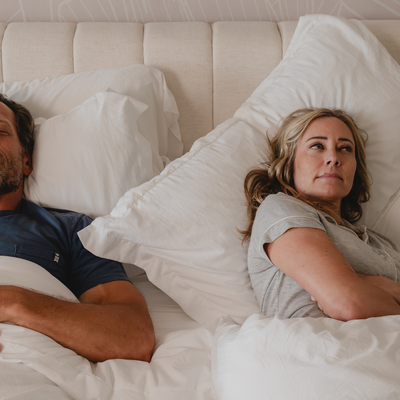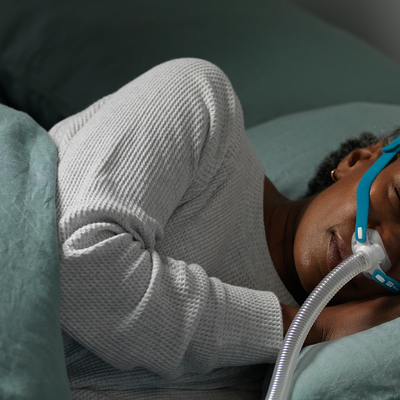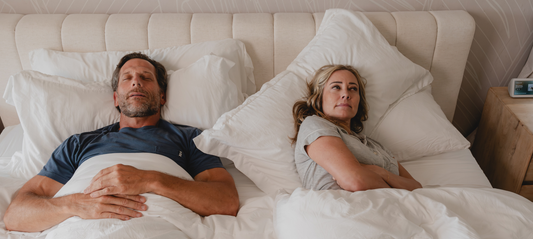
June 25, 2025
Starting CPAP therapy for the first time can feel like a big lifestyle change. If you're like most, you may be feeling unsure about how to get used to the sensation of pressurized air, not to mention the mask on your face. One easy but surprisingly effective way to ease into therapy is by incorporating your CPAP mask into your regular evening routine—before you even go to sleep.
At Lofta, we’ve seen that new users who spend a little time wearing their CPAP mask while doing something relaxing—like watching TV, reading a book, or scrolling through social media (not for too long, of course!)—often adjust faster and have greater long-term success with therapy. Here’s why it works and how you can make it part of your nightly wind-down.
Why Use Your CPAP While You’re Awake?
When you first start CPAP therapy, the feeling of air blowing into your nose or mouth can be disorienting. Your natural response might be to rip the mask off. That’s totally normal. The trick is to get your brain and body familiar with the sensation before it’s time to fall asleep.
By wearing your mask while you’re doing something enjoyable and low-stress—like watching your favorite show, reading a chapter of a good book, or even doing a crossword—you give your mind time to get used to it in a no-pressure environment. You’re training your brain to see the mask as part of your routine, not something foreign that only shows up at bedtime. There are no hard and fast rules to this. But we recommend trying it for at least 2-3 weeks.
Build It Into Your Wind-Down Routine
Creating a consistent evening routine is key for sleep hygiene in general, and it’s especially useful when starting CPAP therapy. Here’s an example of how you might structure your evening:
-
8:30 PM – Turn off bright overhead lights and switch to lamp lighting to signal to your body that it’s time to relax.
-
8:45 PM – Put on your CPAP mask and start your machine. Pick up your book, turn on your show, or scroll your favorite subreddit.
-
9:15 PM – After about 30 minutes, you’ll be more accustomed to the air pressure and the feel of the mask. Now, when it’s time to actually fall asleep, your brain won’t register it as something new. You may even start dozing off early!
-
9:30 PM – Turn out the lights and let yourself drift off—mask already on and acclimated.
This simple strategy can make a world of difference, especially during the first few weeks of therapy.
Pro Tips to Make It Easier
-
Start with shorter sessions: Even just 10–15 minutes of wear time while watching TV can help at first.
-
Practice breathing normally: Try not to fight the air. Relax, and let your body adjust to the airflow. Again, this is a new sensation but try your best to relax.
-
Adjust your mask fit: A leaky or tight mask can be distracting. Make sure your mask is fitted properly and comfortably. It should be snug, but if you have imprints on your forehead or nose, it's definitely too tight.
Need Extra Help? Lofta Is Here for You
Adjusting to CPAP isn’t always easy, and that’s okay. Lofta offers multiple ways to support you as you begin your journey to better sleep:
-
Chat, email, or call us with any questions. Our expert team is here to help with anything from product guidance to tips on comfort and cleaning. Chat online, email at sleep@lofta.com, or call us at 800-698-8000 during business hours.
-
Talk with a respiratory therapist. If you need more personalized support, you can schedule a one-on-one call with a licensed respiratory therapist. These sessions are free for LoftaCare members, or $40 for a one-time consult.
Final Thoughts
Your CPAP therapy is an investment in your health, energy, and long-term well-being. But like any new habit, it takes time to build. Watching TV or reading while wearing your CPAP mask may seem like a small step, but it can dramatically reduce your anxiety around therapy and help you feel more in control of the process.
You don’t have to figure this out alone. Whether you're struggling to adjust or just have a few questions, Lofta is always just a click or call away. Let us help you make CPAP a seamless—and even relaxing—part of your night.


















